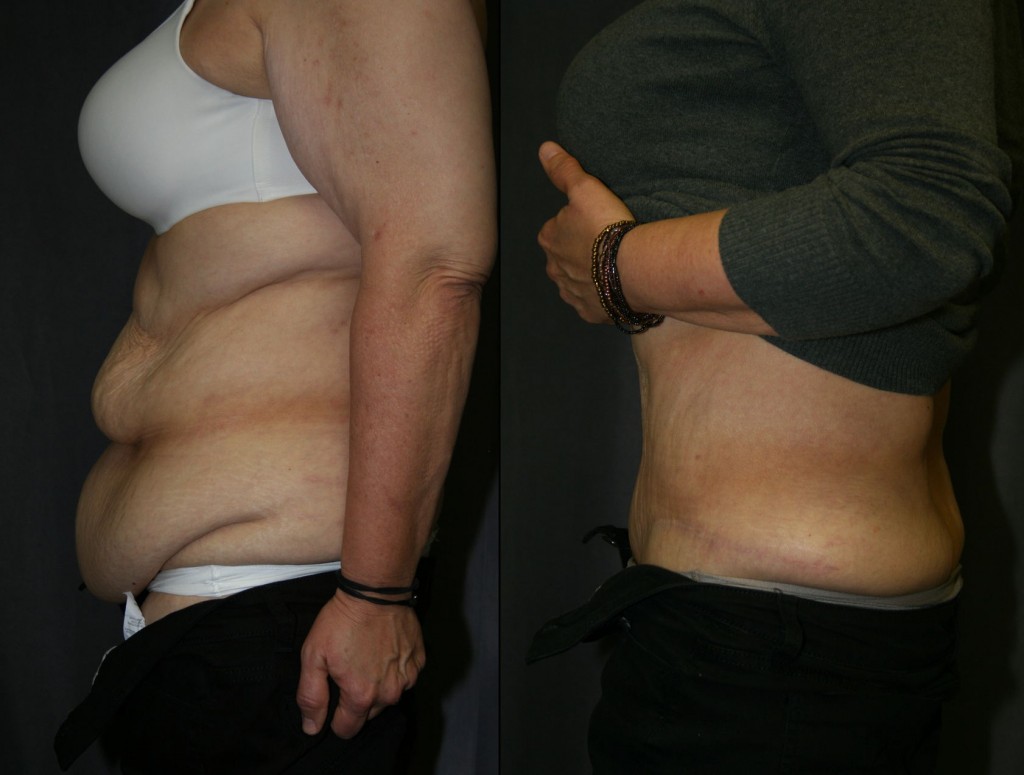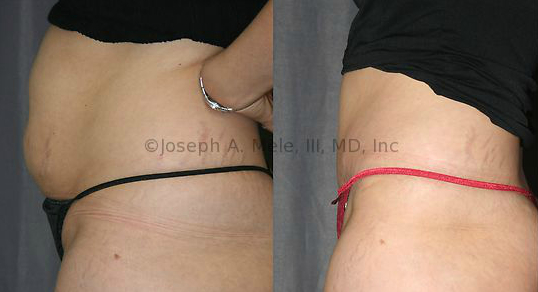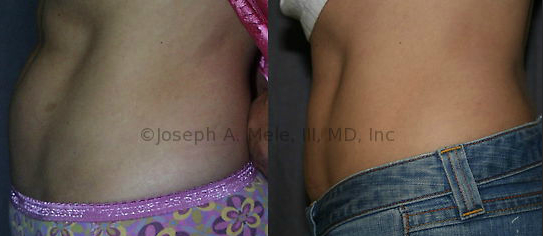The Tummy Tuck remains one of the most satisfying procedures I perform. There is something very rewarding about being able to restore a stomach to its firm, youthful form. Most patients are in good shape. Many are working hard at improving the look of their abdomen; however, exercise alone does not always provide the desired results. Exercise can reduce weight and strengthen muscles, but it cannot shrink skin or tighten an abdominal wall that has been over stretched.
Tummy Tuck Before and After Pictures

Abdominoplasty – Left (before): Multiple rolls of redundant skin are seen after massive weight loss. Right (after): The loose abdominal skin is removed and the muscle wall is tightened, making finding clothes that fit much easier.
Who Gets Tummy Tucks (Abdominoplasty)?
Many of my tummy tuck patients have had children. Their abdomens have stretched due to pregnancy, especially with multiple pregnancies. The baby, like weight gain, stretches the abdominal wall causing both muscle and skin laxity. This can occur even when physically fit. Abdominal wall stretching is compounded by even mild weight gain, as the fat seems to be stored preferentially in the lower abdomen.
Why is the Abdomen More Full at the Bottom?
Extra skin tends to fold over at the belly-button and at the belt line. This happens because most the attachments between the skin and abdominal muscles are loose, allowing gravity to slide the skin down over the muscles when we stand. Dense attachments between the skin and the muscle at the belly button and along the belt line keep the skin from sliding. Redundant skin above these areas accumulates and may fold over itself. The lower abdominal skin folding is accentuated by lower abdominal scars, like the scar from a C-section. The C-section scar firmly glues the skin to the underlying muscle, and gravity pulls any loose skin over the scar enhancing the pooch.
Another reason the abdomen is more full at the bottom has to do with the abdominal wall muscles. Pregnancy and weight gain increase the volume inside the abdominal cavity. This stretches not only the skin but also the tough fascial layers that support the abdominal muscles. When the fascia layers are stretched, the guts can push forward, causing a rounder belly. Tightening the muscles voluntarily can help, but when overstretched, it may not be possible to suck the guts in completely.
Fat retained inside the abdominal cavity can also cause a firm round belly that cannot be sucked in. Fat in this interior location cannot be removed with a tummy tuck or liposuction, and must be lost through diet and exercise. This is part of the reason it is best to be close to your goal weight before having your tummy tuck.
What Can be Done to Flatten the Belly After Pregnancy or Weight Loss?
Tummy Tuck Before and After Pictures 
Tummy Tuck (Abdominoplasty) – Before and After Photos
Tummy Tuck: The Tummy Tuck, or Abdominoplasty, was created to tighten the abdominal wall muscles and to remove excess skin. A tummy tuck also removes excess fat more completely than liposuction. This three pronged approach addresses excess skin, excess fat and lax abdominal muscles. It is the most effective way to rejuvenate the shape of the abdomen. Abdominoplasty smoothes the skin, removes the fat and tightens the abdominal muscles.
Liposuction Before and After Pictures 
Liposuction (Liposculpture) – Before and After Pictures
Liposuction: If the skin tone and muscle wall are already in good shape, Liposuction alone may be sufficient. However, if liposuction is performed with loose skin or muscles, the results will not be optimal. The muscle is not tightened with liposuction, and the skin may lose support from the fat removal and become more irregular.
Mini Tummy Tuck Before and After Pictures 
Mini Tummy Tuck – Before and After Pictures
Mini-Tummy Tuck: The Mini Tummy Tuck, or Mini Abdominoplasty, can help when the muscle and skin laxity is isolated to below the belly button. It does everything a tummy tuck can do below the belly button, and can be combined with liposuction to address disproportionate fat above the belly button or on the sides. For laxity above the belly button, a tummy tuck is still the best choice.
Tummy Tuck Information
More information about tummy tucks is available on my main web site DrMele.com. If you would like specific information regarding what can be done for your tummy, schedule a consultation in our San Francisco Bay Area Plastic Surgery Office in Walnut Creek, California. Call (925) 943-6353 or use the contact form in the column on to the left.
Previous Post Next Post